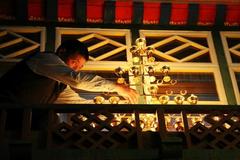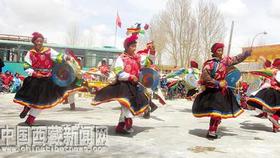Roundup of Tibet’s 10 years of intangible cultural heritage protection
Tibet’s intangible cultural heritage items include Thangka, Gesar story-telling and singing, Tibetan opera, Tibetan incense, Tibetan medicine, Tibetan paper, dances and others.
In 2005, Tibet launched a comprehensive survey of intangible cultural heritage. Over the past ten years, the Central Government and Tibet Autonomous Region have invested nearly 200 million yuan(31.28 million U.S. dollars) in special funds for protection. They have also strengthened the management of heritage lists, development of inheritor teams and establishment of teaching bases. Tibet has successively put together four regional intangible cultural heritage lists and three inheritance lists. Currently, Tibet boasts 68 national-level intangible cultural heritage inheritors and 350 regional-level inheritors. In addition, Tibet has also named 113 intangible cultural heritage teaching venues of various levels and types; four national-level and two regional-level productive protection bases by integrating the distribution and protection status quo of its intangible cultural heritage resource.
Of the five kinds of famous Tibetan paper, "Shora" Tibetan paper is the only type of paper passed down. Shora village is located in Tarrong Township of Nyemo County. Tsering Dorje, born into a well-known local Tibetan paper family, has already been making Shora Tibetan paper for 51 years. In May 2006, Tibetan paper-making techniques were officially included in the first batch of China’s intangible cultural heritage. In 2009, Tsering Dorje became a national-level representative inheritor of Tibetan paper-making skills.
"Duixie", boasting nearly a thousand years of history, is a type of folk singing and dancing art form loved by local Tibetans. In 2007, dancers from Shigatse’s Lhatse County performed the original Tibetan Duixie dance on the CCTV Spring Festival Evening Gala stage. In 2008, Lhatse Duixie Dance was included in the national-level intangible cultural heritage list. Duixie dance is also named the "Chinese tap dance".
Another two styles of dances in Tibet - "Jiuhe Zhuo dance" and "Tengchen Reba dance", were also named as national-level intangible cultural heritage items for protection and also performed at the CCTV dance competition. Cheerful "Duixie", bold and unrestrained "Jiuhe Zhuo dance" and the highly skilled "Tengchen Reba" all illustrate the unique features of Tibetan culture.
Your Comment
Name E-mailRelated News
-
;
-
-

-
Butter-lamp Day
The Butter-lamp Day is celebrated in Tibet today (Oct. 25 in Tibetan calendar) to commemorate the death of Tsongkhapa, the founder of the Gelug Sect of Tibetan Buddhism.
-
-
-

-
Inheritor to introduce oldest Tibetan folk dance to the whole worl
In Jiuhe Village of Xiashui Township, Qiongjie County in Lhoka Prefecture, 80-year-old Nyima was practicing a kind of folk dance in Tibetan known as the Zhuo dance while directing the performances of the whole troupe.
-
-
-

-
"Goddess Festival" – traditional festival for Tibetan women
The 15th day of the tenth month on the Tibetan Calendar,which fell on Nov. 26 this year,is Tibet's traditional festival - the "Goddess Festival".
-











